Agilent 矢量信号分析仪介绍
- 格式:pdf
- 大小:2.97 MB
- 文档页数:12
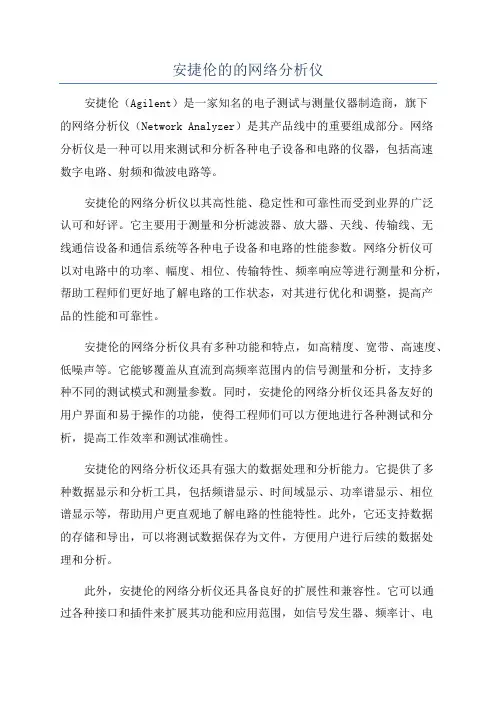
安捷伦的的网络分析仪安捷伦(Agilent)是一家知名的电子测试与测量仪器制造商,旗下的网络分析仪(Network Analyzer)是其产品线中的重要组成部分。
网络分析仪是一种可以用来测试和分析各种电子设备和电路的仪器,包括高速数字电路、射频和微波电路等。
安捷伦的网络分析仪以其高性能、稳定性和可靠性而受到业界的广泛认可和好评。
它主要用于测量和分析滤波器、放大器、天线、传输线、无线通信设备和通信系统等各种电子设备和电路的性能参数。
网络分析仪可以对电路中的功率、幅度、相位、传输特性、频率响应等进行测量和分析,帮助工程师们更好地了解电路的工作状态,对其进行优化和调整,提高产品的性能和可靠性。
安捷伦的网络分析仪具有多种功能和特点,如高精度、宽带、高速度、低噪声等。
它能够覆盖从直流到高频率范围内的信号测量和分析,支持多种不同的测试模式和测量参数。
同时,安捷伦的网络分析仪还具备友好的用户界面和易于操作的功能,使得工程师们可以方便地进行各种测试和分析,提高工作效率和测试准确性。
安捷伦的网络分析仪还具有强大的数据处理和分析能力。
它提供了多种数据显示和分析工具,包括频谱显示、时间域显示、功率谱显示、相位谱显示等,帮助用户更直观地了解电路的性能特性。
此外,它还支持数据的存储和导出,可以将测试数据保存为文件,方便用户进行后续的数据处理和分析。
此外,安捷伦的网络分析仪还具备良好的扩展性和兼容性。
它可以通过各种接口和插件来扩展其功能和应用范围,如信号发生器、频率计、电源等。
同时,它还支持多种通信接口和协议,如GPIB、LAN、USB等,可以与其他设备和系统进行互联互通,方便用户进行综合性能测试和系统集成。
在实际应用中,安捷伦的网络分析仪已广泛应用于各个领域,如电子制造、通信、无线电、航空航天等。
它可以用于产品研发、生产测试、维修和故障排除等各个环节,为工程师们提供了一个强大而可靠的工具,帮助他们更好地完成工作任务。
总之,安捷伦的网络分析仪作为一种高性能的测试与测量仪器,具有多种功能和特点,广泛应用于各个领域。
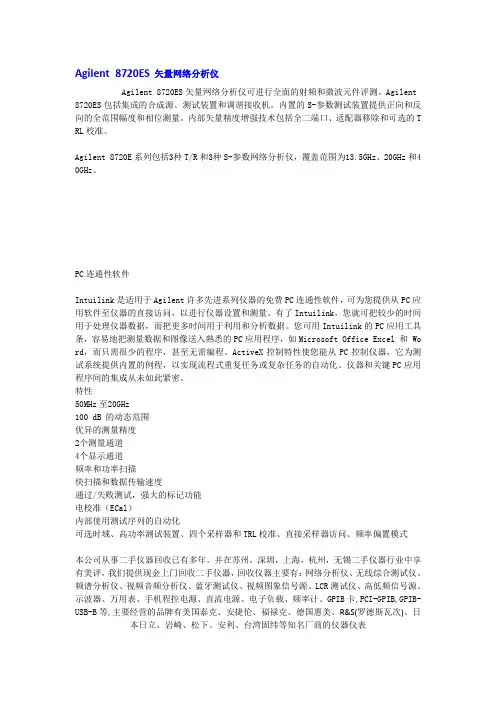
Agilent 8720ES矢量网络分析仪Agilent 8720ES矢量网络分析仪可进行全面的射频和微波元件评测。
Agilent 8720ES包括集成的合成源、测试装置和调谐接收机。
内置的S-参数测试装置提供正向和反向的全范围幅度和相位测量。
内部矢量精度增强技术包括全二端口、适配器移除和可选的T RL校准。
Agilent 8720E系列包括3种T/R和3种S-参数网络分析仪,覆盖范围为13.5GHz、20GHz和4 0GHz。
PC连通性软件Intuilink是适用于Agilent许多先进系列仪器的免费PC连通性软件,可为您提供从PC应用软件至仪器的直接访问,以进行仪器设置和测量。
有了Intuilink,您就可把较少的时间用于处理仪器数据,而把更多时间用于利用和分析数据。
您可用Intuilink的PC应用工具条,容易地把测量数据和图像送入熟悉的PC应用程序,如Microsoft Office Excel 和 Wo rd,而只需很少的程序,甚至无需编程。
ActiveX控制特性使您能从PC控制仪器,它为测试系统提供内置的例程,以实现流程式重复任务或复杂任务的自动化。
仪器和关键PC应用程序间的集成从未如此紧密。
特性50MHz至20GHz100 dB 的动态范围优异的测量精度2个测量通道4个显示通道频率和功率扫描快扫描和数据传输速度通过/失败测试,强大的标记功能电校准(ECal)内部使用测试序列的自动化可选时域、高功率测试装置、四个采样器和TRL校准、直接采样器访问、频率偏置模式本公司从事二手仪器回收已有多年。
并在苏州,深圳,上海,杭州,无锡二手仪器行业中享有美评,我们提供现金上门回收二手仪器,回收仪器主要有:网络分析仪、无线综合测试仪、频谱分析仪、视频音频分析仪、蓝牙测试仪、视频图象信号源、LCR测试仪、高低频信号源、示波器、万用表、手机程控电源、直流电源、电子负载、频率计、GPIB卡,PCI-GPIB,GPIB-USB-B等,主要经营的品牌有美国泰克、安捷伦、福禄克、德国惠美、R&S(罗德斯瓦次)、日本日立、岩崎、松下、安利、台湾固纬等知名厂商的仪器仪表二Agilent 8720ES|HP8720ES|HP-8720ES 20G微波矢量网络分析仪50MHz-20GHz厂商:美国安捷伦Agilent*频率范围:50MHz到13.5,20或40GHz*提供传输/反射或S参数测试装置备选品*快的测量速度和数据传送速率*同时显示多达4个参数*达105db动态范围*可选用时域,频率偏移和高功率测量技术指标摘要8719ET 8720ET 8722ET型号8719ES 8720ES 8722ES最低频率50MHz 50MHz 50MHz最高频率13.5GHz 20GHz 40GHz频率分辨率1Hz 1Hz 1Hz频率精度10ppm 10ppm 10ppm最大信号源功率0dBm,<20GHz;-5dBm,20~40GH ET型+10dBm +10dBmz-5dBm,<20GHz;-10dBm,20~40G ES型+5dBm +5dBmHz带选件007的ES型+10dBm +10dBm 0dB,<20GHz;-5dBm,20~40GHz 最小信号源功能率:ET型(标准)-10dBm -10dBm -15dBm带选件004的ET型-65dBm -65dBm -70dBmES型(标准)-70dBm -70dBm -75dBm带选件007的ES型-65dBm -65dBm -70dBm功率分辨率0.01dB 0.01dB 0.01dB功率平坦度±2dB ±2dB ±3dB15dB,20GHz以功率扫描范围20dB 20dB下;10dB,20~40GHz系统动态范围(>2GHz)84~97dB(ET)ET型104dB 104dB 80~93dB(ES)ES型100dB 100dB 85~98dB带选件007的ES型105dB 105dB 2.4mm(阳)测试端口连接器 3.5mm(阳) 3.5mm(阳)表中数据适用于23℃±3℃,有关更全面的技术指标和误差修正后的总测量不确定度,请参见产品技术资料8720E系列网络分析仪8720E系列的特点是拥有能满足您的测量需要的6种矢量网络分析仪.8719ET.8720ET和8722ET型提供经济的传输/反射测试装置,而8719ES,8720ES和8722ES型则提供S参数测试装置和适于您的应用的广泛配置选择.ET型以适中的价格提供正向传输和反射测量.ES型能提供正向和反响测量以及使测量有最高精度的全二端口校准.ET型和ES型将快速合成源与成化测试想结合,频率覆盖范围从50MHz到13.5,20或40 GHz.8720E系列小型,经济且便于使用,能对微波线性和非线性器件进行精确.快速测试.这些仪器是改善您在研发过程的设计或在生产过程中实现最高测量效率的优良工具.ET型8719ET .8720ET .和8722ET的特点是有一个内置传输/反射测量装置,用于在正向上进行各种各样的幅度和相位测量.内置矢量精度提高技术包括单端口响应和增强响应校准.增强响应校准通过对不能进行常规响应校准的源匹配效应的修正来改善传输测量的精度.可选用的55dB步进衰减器为测试有源器件提供各种不同的输出功率电平.ES型8719ES .8720ES .和8722ES的特点是有带二端口误差修正的固态开关S参数测试装置.ES型包含一个作为标准件的55 dB步进衰减器,以提供大的输出功率范围.增强响应校准通过对源匹配进行修正来改善传输测量的精度,但没有全二端口校准的速度损失.适配器去除校准对测量非插入式器件,如两个端口上同为阴性或同为阳性连接器的器件或在端口1和2上有不同连接器类型的器件提供更高的精度.电子校准(Ecal)利用85097A ECal VNA接口配件和适当的N4690微波ECal模块,由一次接连提供快速.简单的校准,这需要85097B-100电缆.一些Agiletn公司认可的联锁供应商可以提供能与Agilent公司的网络分析仪产品配用的测量硬件和软件,从而能为您的测试需要提供完整的解决方案.适合于各种应用的灵活配置选件004增加55dB步进衰减器以扩大输出功率范围(只用于ET<span style="font-size:9.0pt;font-family:宋体;mso-ascii-font-family:Tahoma;mso-hansi-font-family: Tahoma;mso-bidi-font-family:Taho点击放大图。
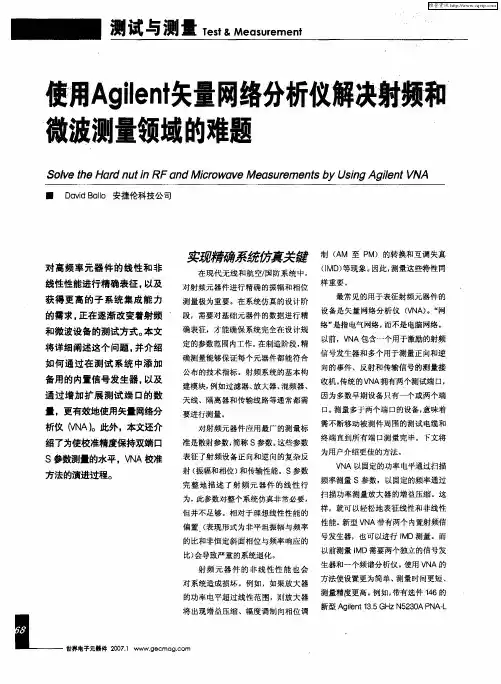
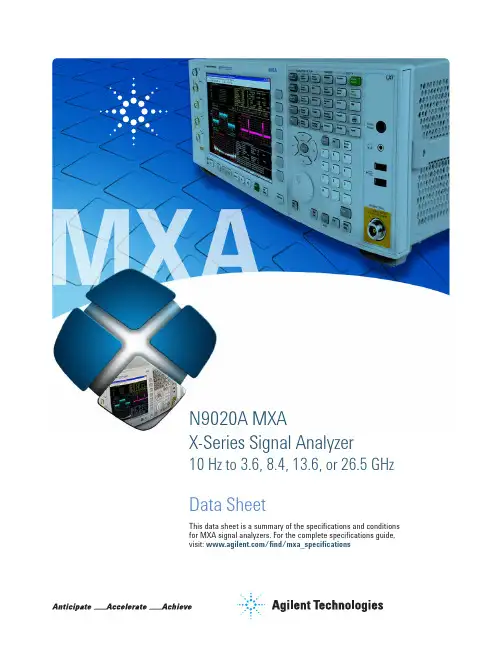
N9020A MXAX-Series Signal Analyzer10 Hz to 3.6, 8.4, 13.6, or 26.5 GHz Data SheetThis data sheet is a summary of the specifications and conditions for MXA signal analyzers. For the complete specifications guide, visit: /find/mxa_specificationsTable of ContentsAccelerate to marketEvery device demands decisionsthat require tradeoffs in your goals—customer specs, through-put, yield. With a highly flexible signal analyzer, you can manage and minimize those tradeoffs. Agilent’s mid-performance MXA is the ultimate accelerator as your products move from design to the marketplace. It has the flexibility to quickly adapt to your evolving test requirements—today and tomorrow. Maximize your flexibil-ity, and accelerate to market, with the Agilent MXA signal analyzer.Definitions and Conditions ...................................................3Frequency and Time Specifications ............................................4Amplitude Accuracy and Range Specifications ...................................6Dynamic Range Specifications ................................................8PowerSuite Measurement Specifications ......................................12General Specifications ......................................................13Inputs and Outputs ........................................................14IQ Analyzer ...............................................................16IQ Analyzer - Option B40 ....................................................17IQ Analyzer - Option B85/B1A/B1X ...........................................18Real-Time Spectrum Analyzer (RTSA). . . . . . . . . . . . . . . . . . . . . . . . . . . . . . . . . . . . . . . . . . 19Related Literature (20)Definitions and ConditionsSpecifications describe the performance of parameters covered by the product warranty and apply to the full temperature range of 0 to 55 °C 1, unless otherwise noted.95th percentile values indicate the breadth of the population (approx. 2 σ) of performance tolerances expected to be met in 95 percent of the cases with a 95 percent confidence, for any ambient temperature in the range of 20 to 30 °C. In addition to the statistical observations of a sample of instruments, these values include the effects of the uncertainties of external calibration references. These values are not warranted. These values are updated occasionally if a significant change in the statistically observed behavior of production instruments is observed.Typical describes additional product performance information that is not covered by the product warranty. It is performance beyond specifications that 80 percent of the units exhibit with a 95 percent confidence level over the temperature range 20 to 30 °C. Typical performance does not include measurement uncer-tainty.Nominal values indicate expected performance, or describe product performance that is useful in the application of the product, but are not covered by the prod-uct warranty.The analyzer will meet its specifications when:• It is within its calibration cycle• Under auto couple control, except when Auto Sweep Time Rules = Accy • Signal frequencies < 10 MHz, with DC coupling applied• The analyzer has been stored at an ambient temperature within the allowed operating range for at least two hours before being turned on; if it had previ-ously been stored at a temperature range inside the allowed storage range, but outside the allowed operating range• The analyzer has been turned on at least 30 minutes with Auto Align set to normal, or, if Auto Align is set to off or partial, alignments must have been run recently enough to prevent an Alert message; if the Alert condition is changed from Time and Temperature to one of the disabled duration choices, the analyzer may fail to meet specifications without informing the userFor the complete specifications guide, visit:/find/mxa_specifications1. For earlier instruments (Serial number prefix < MY/SG/US5051), the full temperature ranges from5 to 50 °C.Frequency and Time Specifications1. Horizontal resolution is span/(sweep points – 1).1. Analysis bandwidth is the instantaneous bandwidth available around a center frequency over which the input signal can be digitized for further analysis orprocessing in the time, frequency, or modulation domain.2. Sweep points = 101. Apply for instruments with S/N prefix ≥ MY/SG/US4910 or earlier instruments with Option PC2 or PC4. Otherwise, refer to theMXA specification guide.Amplitude Accuracy and Range Specifications1. DC coupling required to meet specifications below 50 MHz. With AC coupling, specifications apply at frequencies of 50 MHz and higher. Statistical observa-tions at 10 MHz with AC coupling show that most instruments meet the DC-coupled specifications, however, a small percentage of instruments are expected to have errors exceeding 0.5 dB at 10 MHz at the temperature extreme. The effect at 20 to 50 MHz is negligible but not warranted.2. Apply for instruments with S/N prefix ≥ MY/SG/US5051. For older instruments, refer to the MXA Specification Guide.Dynamic Range Specifications1. N is the LO multiplication factor.Figure 1. Nominal dynamic range – Band 0, for second and third order distortion, 20 Hz to 3.6 GHzFigure 2. Nominal dynamic range – Bands 1 to 4, for second and third order distortion, 3.6 GHz to 26.5 GHz1. Applies for instruments with serial number prefix ≥ MY/SG/US5233. Those instruments ship standard with N9020A-EP2 as the identifier. For nominal valuesat other center frequencies, refer to Figure 3. For earlier instruments, refer to the MXA specifications guide.Figure 3. Nominal phase noise at different center frequencies (Applies for instruments with SN prefix ≥ MY/SG/US5233; ships standard with N9020A-EP2)PowerSuite Measurement SpecificationsGeneral SpecificationsInputs and Outputs1. For additional specifications, please refer to the MXA Signal Analyzer Option BBA: Analog Baseband IQ Inputs Technical Overview,literature number 5989-6538EN.2. For more details, please refer to the Agilent Probe Configuration Guides, literature numbers 5968-7141EN and 5989-6162EN; probe heads are necessary toattach to your device properly and probe connectivity kits such as E2668B, E2669A. or E2675A are required.1. Option MPB installed and enabled.I/Q Analyzer1. Option MPB is installed and enabled.I/Q Analyzer (continued)Option B40 (40 MHz analysis bandwidth, Option B40 is automatically included in Option B85, B1A or B1X)1. Option MPB is installed and enabled.I/Q Analyzer (continued)Option B85/B1A/B1X (85/125/160 MHz analysis bandwidth)1. Option MPB is installed and enabled.1. For additional RTSA specifications, please refer to Option RT1/RT2 Chapter in the MXA Signal Analyzer specification guide (part number: N9020-90113)2. StM = “Signal-to-Mask”Real-Time Spectrum Analyzer (RTSA) 1Option RT1 or RT2Related LiteratureAgilent MXA signal analyzers Brochure5989-5047ENConfiguration Guide 5989-4943EN For more information or literature resources please visit the web:/find/mxacdma2000® is a registered certification mark of the Telecommunications Industry Association. Used under license./quality/find/AdvantageServices Accurate measurements throughout the life of your instruments.Agilent Advantage ServicesThree-Year Warranty/find/ThreeYearWarranty Agilent’s combination of product reliability and three-year warranty coverage is another way we help you achieve your business goals: increased confidence in uptime, reduced cost of ownership and greater convenience.For more information on AgilentTechnologies’ products, applications or services, please contact your local Agilent office. The complete list is available at:/find/contactus Americas Canada (877) 894 4414 Brazil (11) 4197 3600Mexico 01800 5064 800 United States (800) 829 4444 Asia Pacific Australia 1 800 629 485China 800 810 0189Hong Kong 800 938 693India 1 800 112 929Japan 0120 (421) 345Korea 080 769 0800Malaysia 1 800 888 848Singapore 180****8100Taiwan 0800 047 866Other AP Countries (65) 375 8100 Europe & Middle East Belgium 32 (0) 2 404 93 40 Denmark 45 45 80 12 15Finland 358 (0) 10 855 2100France 0825 010 700**0.125 €/minuteGermany 49 (0) 7031 464 6333 Ireland 1890 924 204Israel 972-3-9288-504/544Italy 39 02 92 60 8484Netherlands 31 (0) 20 547 2111Spain 34 (91) 631 3300Sweden 0200-88 22 55United Kingdom 44 (0) 118 927 6201For other unlisted countries: /find/contactusRevised: January 6, 2012Product specifications and descriptions in this document subject to change without notice.© Agilent Technologies, Inc. 2013Published in USA, July 31, 20135989-4942EN/find/mxaLAN eXtensions for Instruments puts the power of Ethernet and the Web inside your test systems. Agilent is a founding member of the LXI consortium.Agilent Channel Partnersw w w /find/channelpartners Get the best of both worlds: Agilent’s measurement expertise and product breadth, combined with channel partner convenience./find/myagilentA personalized view into the information most relevant to you.myAgilentmy Agilent。


矢量信号分析仪原理
矢量信号分析仪是一种广泛应用于电信、无线通信、雷达等领域的测试仪器,用于对复杂信号进行分析和测量。
它可以同时测量信号的幅度和相位,并绘制在频率域上的频谱图。
矢量信号分析仪的原理是基于频谱分析和时域采样的原理。
当输入信号进入仪器时,它首先被分成一系列时域采样的数据点。
然后利用傅里叶变换将这些数据点转换为频域上的频谱图,显示出信号在不同频率上的能量分布。
在分析过程中,矢量信号分析仪通过对信号进行幅度和相位的解调,得到信号在不同频率上的相对强度和相位信息。
这些信息可以帮助工程师了解信号的特性和性能,并进行相应的优化和调整。
此外,矢量信号分析仪还可以通过多种数学运算和滤波器对信号进行进一步的处理和分析。
例如,可以对信号进行包络检测、频率偏移检测、调制深度检测等,以获取更全面的信号特性信息。
总的来说,矢量信号分析仪通过将信号转换为频域上的频谱图,并解调信号的幅度和相位信息,实现对复杂信号的分析和测量。
它在无线通信系统和其他领域中具有重要的应用价值,可以帮助工程师进行信号调优和系统优化。
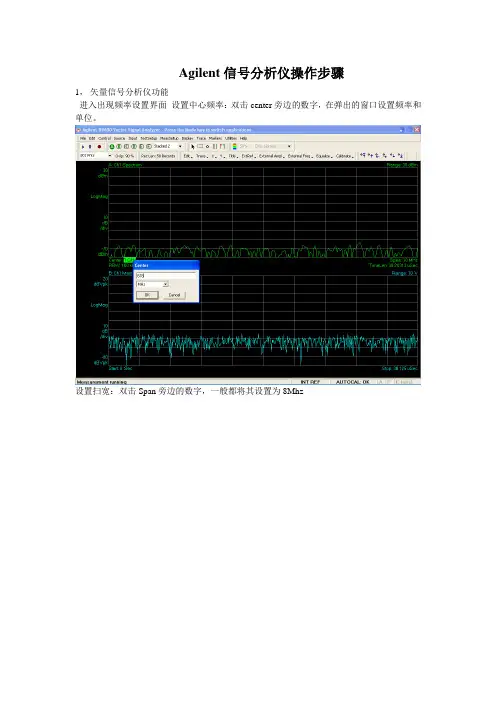
Agilent信号分析仪操作步骤1,矢量信号分析仪功能进入出现频率设置界面设置中心频率:双击center旁边的数字,在弹出的窗口设置频率和单位。
设置扫宽:双击Span旁边的数字,一般都将其设置为8Mhz设置range 单击range旁边的数字按向下键将波形图调至中心位置。
(-20dbm左右)选择菜单中的MeasSetup——Demodulator——Digital Demod。
进入数字信号分析功能。
选择图形个数查看星座图(双击左侧绿色方框,在弹出的对话框中选择constellation)查看I眼图(双击左侧绿色方框,在弹出的对话框中选择I-Eye)查看Q眼图(双击左侧绿色方框,在弹出的对话框中选择Q-Eye)进入扫频仪后界面如下设置起始频率,选择功能键Stop Freq设置终止频率,选择Center Freq设置中心频率。
按控制面板上的SPAN x Scale键出现如下界面,选择功能键Span设置扫宽按控制面板上的AMPTD y Scale键出现如下界面,选择功能键More 1of2选择Y Axis Unit 设置电平的单位。
按控制面板上的Trace Delecter键,选择功能键盘Trace Average后出现平滑的曲线。
按控制面板上的Input/Output键,选择功能键RF Input [AC,50欧],选择75欧。
按控制面板上的BW键,出现如下界面。
分别对RBW和VBW进行设置使曲线接近平滑,建议RBW设置为500-600khz左右,VBW设置为20khz左右,这样兼顾了曲线的平滑与扫频的速度。
按控制面板上的Maker 键后输入频率与单位,设置游标。
按控制面板上的Maker Function后可以选择有一定带宽范围的游标,出现如下界面。
选择功能键Band/Interval Density。
选择功能键Band Adjust调整宽度,如需关闭选择Maker Function Off。
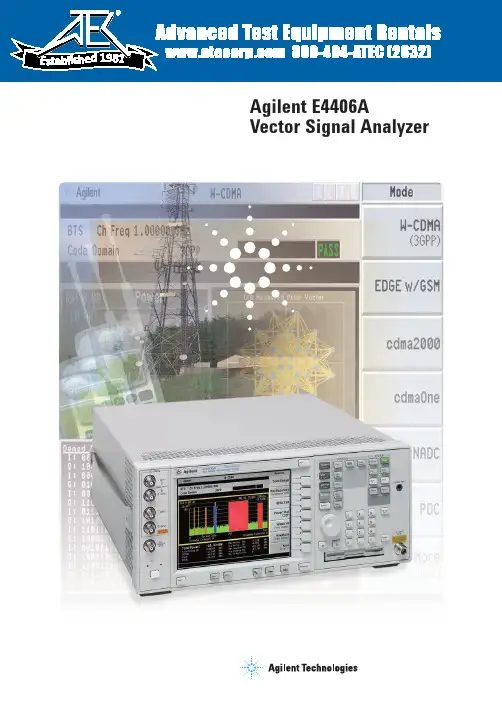
1981Agilent E4406AVector Signal AnalyzerAccuracyS p e e d2Fast and accurate measurements To stay competitive, wireless equipment manufacturers need flexible test equipment capable of testing different formats with little change in set-up. The Agilent E4406A vector signal analyzer (VSA) is the perfect fit, offering the best combination of speed and accuracy for making one-button,standards-based measurements.2.5G and 3G formatsFor engineers developing next-generation wireless components and systems, the E4406A provides W-CDMA, cdma2000,1xEV-DO and EDGE/GSM formats. Using one-button measurements, engineers can quickly verify conformance to these new formats. As the standards have evolved, we have continued to enhance existing measurement personalities, and add new ones. The modular architecture of the E4406A makes it simple for you to upgrade and be ready for the latest standards.You develop the wireless future…Easy to useMulti-format3…we provide the signal analysis.An investment for your future The number of wireless technologies deployed around the world is growing and the demand for any particular format can change quickly. The E4406A offers format and frequency flexibility.Comprehensive signal analysis Speeding up production means being ready to manufacture anything and lose no time doing it. The E4406A easily adapts to virtually any popular format:•W-CDMA •cdma2000•1xEV-DO •cdmaOne •EDGE •GSM •NADC •PDC •iDEN •Spectrum •Waveform“We have decreased the (transmitter power calibration)test time by 25%.”–T est Systems Designer4Built for speed…Fast standards-based measurements As a wireless system or componentmanufacturer, you are under pressure to increase throughput while minimizing capital investments. Long test times can severely limit your manufacturing throughput, so we designed the E4406A.Since its introduction, progressive enhancements to the E4406A ensure its performance keeps pace with the ever-increasing need for speed.Today's E4406A is faster than ever. For example, the W-CDMA adjacent channel power ratio (ACPR) measurement is now nearly eight times faster than it used to be.Output radio frequency spectrum (ORFS) is two times faster, W-CDMA code domain power (CDP) is five times faster, and other measurements have improved as well.The E4406A transmitter power calibration uses time record data and built-in algorithms to provide complete transmitter level calibration with incredible speed – with all the accuracy you expect from the affordably-priced E4406A.In addition to high-speed throughput and accuracy in the manufacturing environment,the E4406A is designed to allow research and development engineers to quickly obtain results with minimal keystrokes.The E4406A delivers a logical user interface and a wealth of quick “one button” measurments, enabling designers to quickly try multiple test without getting bogged down in crypitic menus. The E4406A interface provides the edge needed to expediently evaluate new designs and successfully meet the demands of today's competitive environment.Base station transceiver suite of testsTypical spectrum analyzerNow even faster…without giving up accuracy.Fast spectrum measurementsThe E4406A features pre-configured, one-button measurements for many cellular standards and can also be used for narrowband spectrum measurements. Manufacturers can expect to make inter-modulation distortion and other amplitude measurements up to three times faster using the E4406A. AccuracyYou don’t need to reduce measurementspeed to get accurate results. Superiorabsolute level accuracy of ±0.6 dB(±0.4 dB typical) provides unmatchedperformance and minimizes test uncertainty.Combined with a linearity of ±0.25 dBover a 76 dB range, the E4406A is astate-of-the-art measurement tool.Absolute level accuracyNarrow span spectrum measurement over GPIB E4406A VSA spectrum analyzer25 updates/second Typicalspectrumanalyzer56The E4406A VSA…Focused applications including EDGE, GSM,W-CDMA, cdma2000, 1xEV-DO, cdmaOne,and NADC as well as narrow-span spectrum and waveform analysisBaseband measurements with balanced/unbalanced multiple impedance inputsLarge,high-resolution, color display makes viewing multiple traces easyZoomfeature allows users to display selected measurement windowsAutomatic alignment ensures accurate measurement resultsOne-button,standards-based measurements7…comprehensive signal analysis.High-speed LAN, parallel, and GPIB ports provide speed and flexibility whenIntuitive key strokesBuilt-in floppy disk drive provides PC compatibility and data archivingManufacturing8Standards complianceIn manufacturing, you need straightforward pass/fail verification of critical specifications.With built-in test limits you don ’t have to keep track of every standard. The E4406A performs tests to the requirements of current industry standards with free, easy-to-install, firmware updates.Speed and throughputIn the world of high-speed manufacturing every millisecond counts. Identify your throughput restrictions and if measurement speed is creating a bottleneck, consider the significant speed advantage of the E4406A.Transmitter and receiver testingIn combination with the Agilent E4438C ESG vector signal generator, the E4406A offers base station receiver and transmitter testing for major 2G, 2.5G, and 3G wireless formats.The E4406A combined with an E4438C is a test solution that provides the required flexibility, without compromising accuracy, for maximum throughput in base station production with the ability to migrate to new formats.Designed for manufacturing…Development9Verify next-generation designs For R&D engineers developing next-generation wireless components and systems, the E4406A is a low-cost tool that quickly verifies conformance. Your investment is secure because the E4406A has a modular architecture – making it easy to upgrade to the latest standards.Characterize using leading test methodsDigital modulation presents new challenges to amplifier manufacturers.Designers need effective methods to quickly characterize digital signals. The E4406A ’s complementary cumulative-distribution function (CCDF) is useful for determining a signal ’s power statistics,revealing the power peaks relative to the average power for assessing linearity requirements.Flexible power measurements Multicarrier power amplifier (MCPA)designers are faced with new measurement challenges. Designers must characterize intermodulation distortion at many frequency offsets and evaluate the effects of different modulation formats over a wide dynamic range. The E4406A features a fully-configurable ACP measurement that can test up to five frequency offsets and be optimized for dynamic range or speed.…and product development.10GSM with EDGE (Option 202)The EDGE measurement personality performs the latest standards-based measurements, including:•Error vector magnitude (EVM)•Multi-slot power versus time (PvT)•ORFS •IQ offset•Channel plans for 400, 800, 900, 1800, 1900 MHz•GSM measurements from Option BAH The EVM measurement features a unique algorithm to simultaneously display the EVM numerical results and the EDGE constellation diagram using the industry-specified measurement filter.GSM (Option BAH)The GSM measurement personality lets you quickly perform measurements to the latest ETSI standards:•Mean transmitter carrier power •Multi-slot PvT •ORFS•Phase and frequency error (PFER)•IQ offset•Transmitter band spurious•Channel plans for 400, 700, 800, 900, 1800, 1900 MHzThe personality features easy channel and timeslot selections, configurable PvT masks,and a typical ORFS dynamic range of 90 dB.NADC and PDC (Option BAE)Both the North American Digital Cellular (NADC) and Personal Digital Cellular (PDC)measurement personalities are included in this option. The NADC measurements are structured according to the IS-136 TDMA standard. Measurements included in this option are:•ACP •EVM•Occupied bandwidth (for PDC)The personalities feature base station and mobile radio mode set-ups, as well as sync word search capability.iDEN (Option HN1)The iDEN measurement personality performs measurements to the Motorola iDEN specialized mobile radio format. •Occupied bandwidth (OBW)•ACPR•Transmitter bit error rate (BER)TDMA measurement personalities…11W-CDMA (Option BAF)The complexity of W-CDMA demands the flexibility and depth of demodulation capability provided by this personality.Perform the following measurements on the HPSK uplink or downlink QPSK signals:•Code domain •QPSK EVM•Modulation accuracy (composite rho and EVM)•Channel power•Adjacent channel power leakage ratio (ACLR)•Power control •PvT•Intermodulation distortion •Multicarrier power•Spectrum emission mask •OBW •CCDFThis personality has the ability toautomatically determine active channels,to synchronize with any W-CDMA channel,to display code domain power in a multi-rate view, and to demodulate down to the symbol level. Variable capture intervals and pre-defined test models enable the user to perform fast, accurate measurements for manufacturing or in-depth analysis for R&D.cdma2000 (Option B78)The cdma2000 measurement personality offers the logical upgrade path from IS-95 to IS-2000 testing. Measurements support the forward and reverse links.•Code domain •QPSK EVM•Modulation accuracy (composite rho and EVM)•Channel power •ACPR•Intermodulation distortion •Spectrum emission mask •OBW •CCDFAdvanced code domain analysis algorithms display Walch codes for either Hadamard or OVSF coding schemes in a multi-rate view. Other capability includes code domain power error, symbol EVM,symbol power versus time, active channel identification, variable PN offset, quasi-orthogonal functions and demodulated symbol bit displays after de-spreading.… and CDMA measurement personalities.12Expanding measurement potential…cdmaOne (Option BAC)Built on Agilent ’s pioneering efforts in CDMA measurement techniques,this personality provides quick and easy measurement set-ups for the TIA/EIA-95, J-STD-008,IS-97D, and IS-98D band classes:•Modulation accuracy (rho)•Code domain •Channel power •ACPR•Close-in spuriousAlong with the world ’s fastest ACPR measurements, this personality features PN (pseudo-noise sequence) search, time offset, and carrier feed-through analysis.1xEV-DO (Option 204)With digital demodulation analysis, the 1xEV-DO measurement personality provides the most comprehensive, easy-to-use,1xEV-DO measurement solution available in an analyzer. This personality, which performs measurements for both forward link and reverse link signals, provides key transmitter measurements for analyzing systems based on the 3GPP2 and TIA/EIA/IS-856 standards.Forward link•Channel power•Power versus time mask •Spurious emissions and ACP •Intermodulation distortion •OBW•Code domain•Modulation accuracy (composite rho)•QPSK EVM•Power statistics (CCDF)Reverse link •Code domain•Modulation accuracy (composite rho)For forward link, the PvT mask and spurious emissions/ACP measurements support both the idle slot (burst signal) and active slot (full power signal). With the auto-burst search function, you can see the standard-based time mask for the 1xEV-DO idle slot in PvT. Code domain, modulation accuracy (composite rho), and QPSK EVM can also measure for each channel ’s Pilot, MAC, and Data in QPSK/8PSK/16QAM. Designed with flexibility in mind, this personality supports the unique 1xEV-DO forward link signals ’feature of time divisions multiplex (TDM). For reverse link, code domain, and modulation accuracy provide powerful modulation analysis functions for transmitter tests.13IQ inputs (Option B7C)Capitalize on the E4406A ’s demodulation capabilities by extending the measurement range to baseband. The baseband IQ input option enables engineers to measure the complete signal path of a receiver or transmitter and directly compare signals both before and after frequency conversion and IQ (de)modulation.Ideally suited for R&D engineers and manufacturing environments, this option allows measurement of baseband I and Q signals in either balanced or unbalanced systems. Input configurations include 50-ohm unbalanced, 600-ohm balanced, and 1-Mohm balanced or unbalanced –enabling a variety of systems to be directly tested without cumbersome and error-inducing conversion networks.Applicable in-band 3GPP W-CDMA,cdma2000, EDGE/GSM, and Basic mode measurements are supported via RF and IQ inputs, enabling engineers to track down signal degradation both before and after RF/IF conversion.Additional features include auto calibration of input signals, variable dc offsets and a dc to 5-MHz input frequency range (10 MHz in I + jQ mode)....tailored to user requirements.14E4406A VSA/89601Asoftware combinationThe standards-based, one-button test capabilities of the E4406A can be expanded with the flexible digital demodulation and analysis capabilities of the Agilent 89601A PC software. This teaming provides fast and accurate data acquisition with powerful,flexible modulation analysis tools for, both common and evolving communications standards.The 89601A vector signal analysis software is the heart of the Agilent 89600 series of vector signal analyzers. This software provides flexible tools for demodulating and analyzing even the most advanced digital modulations, whether or not they are contained in an established standard. Features include variable block size signal acquisition with user-selectable pulse search and synch words, and a user-con-trollable adaptive equalizer. Filter types include cosine (raised and square-root raised), Gaussian, and low-pass – all with configurable alpha/BT. Supported modula-tion formats for both continuous and burst carriers include FSK (2, 4, 8, and 16 level),BPSK, QPSK, OQPSK, DQPSK, p/4DQPSK,8PSK, QAM (16 to 256 level), VSB (8 and 16 level), EDGE, and MSK.The software also provides signal capture and analysis features, such as the capability to download signal capture files for playback through signal generators,and display high-speed spectrograms.The 89601A software runs on a PC connected to the E4406A, via LAN or GPIB,and provides hardware control and results displays along with modulation analysis.Coupling speed and power…15/find/vsa…with Agilent’s tradition of excellence.Service and supportThe speed and accuracy of the E4406A VSA is only a small part of what you get from Agilent. We strive to provide complete solutions that go beyond our customers ’expectations. Only Agilent offers the depth and breadth of enhancements, software, services, connectivity, accessibility, and support to help you reach your measurement objectives. For more information on the E4406A VSA, including product and application literature, visit our Web site at /find/vsaPre-sales service• rentals, leasing, and financing • application engineering services Post-sales service• standard 3-year global warranty • Worldwide Call Center and Service Center support network • one-year calibration intervals • firmware upgrades downloadable from the Web PC connectivity • 10 baseT LAN port • floppy disk drive • GPIB interface• VXI Plug and Play driversPeripheral and product interfaces • parallel printer port • printer support • VGA monitor output• Agilent E4438C ESG vector signal generator•Agilent 89601A vector signal analysis softwareTraining and access to information • on-site user training • factory service training• Web-based support of frequently asked questions• manuals on CD-ROM and on the Web Software• programming examples on CD-ROM • SCPI (Standard Commands for Programmable Instruments)• PC-based performance verification and adjustment softwareOrdering Array informationE4406A vector signal analyzerModel DescriptionE4406A7 MHz to 4 GHzOption DescriptionDigital Demodulation MeasurementsE4406A-202EDGE with GSM measurementpersonalityE4406A-2041xEV-DO measurementpersonalityE4406A-B78cdma2000 measurementpersonalityE4406A-BAC cdmaOne measurementpersonalityE4406A-BAE NADC, PDC measurementpersonalityE4406A-BAF W-CDMA measurementpersonalityE4406A-BAH GSM measurement personality E4406A-HN1IDEN measurementpersonalityInputs and outputsE4406A-300321.4 MHz IF outputBBIQE4406A-B7C I/Q inputsCalibration documentationE4406A-UK6Commercial calibrationcertificate with test data AccessoriesE4406A-1CM Rack mount kitE4406A-1CN Handle kitE4406A-1CP Rack mount and handle kitE4406A-1CR Rack slide kit* Includes English manual set.。
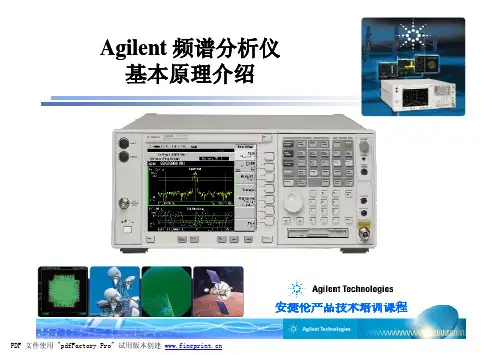
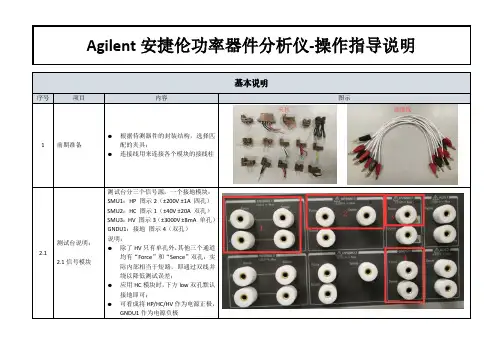
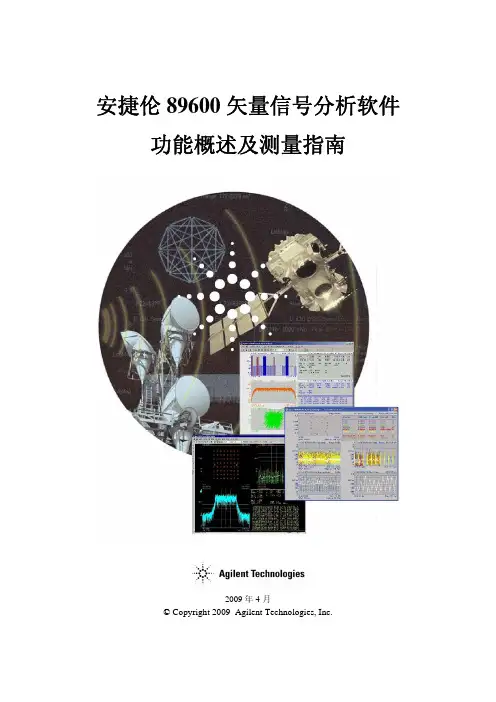
安捷伦89600矢量信号分析软件功能概述及测量指南2009年4月© Copyright 2009Agilent Technologies, Inc.通告本文档所含内容如有修改,恕不另行通知。
安捷伦对本资料不作任何形式的保证,包括但不限于为特定目的的适销性和适用性所作的暗示保证。
对其中包含的错误或由供给、使用本资料或由本资料的实用性而引起的偶然或继发的损失,安捷伦不承担任何责任。
© Agilent Technologies, Inc. 2009在安捷伦没有预先同意之前。
不得以任何形式复制本手册中的任何部分(包括电子存储和检索或翻译为其它语言)。
简介本手册介绍了安捷伦89600矢量信号分析软件的基本功能并重点说明了其数字解调分析功能及操作流程。
同时给出89600 矢量信号分析软件的多种数字解调分析工具和故障诊断方法。
通过对QPSK和W-CDMA信号的测量举例,详细描述了使用89600 矢量信号分析软件进行解调分析的测量过程和操作步骤。
其它信息欲获得更多信息,包括最新的产品信息、软件升级和应用信息,请访问下列网址:/find/89600目录Agilent 89600 VSA软件描述 (5)配置 (5)包含两个应用模式 (5)可接收多个测量前端的数据 (5)设计流程中应用Agilent 89600 VSA软件 (6)软件编程 (6)Agilent 89600 VSA软件功能举例 (7)宽频带测量 (7)窄扫宽超高分辨率测量 (7)捕获完整信号 (7)使用Bandpower Markers简化信道功率测量 (8)录制信号以延展分析能力 (9)使用模拟解调分析信号的建立过程 (9)使用模拟解调定位残余调制 (9)使用数字解调隔离符号时钟错误 (10)使用数字解调更容易地发现滤波问题 (10)使用窗口灵活配置用户化工具栏和显示 (11)结合Agilent ADS的分析 (12)数字解调分析 (13)数字解调器工作原理 (13)数字解调器设置十步骤 (13)QPSK解调分析步骤 (13)分析工具 (16)矢量图 (17)星座图 (17)眼图 (18)I/Q vs时间 (18)解调频谱 (19)误差矢量幅度 (19)幅度和相位误差 (20)误差矢量频谱 (21)符号表/错误摘要 (21)自适应均衡结果:脉冲响应和信道响应 (22)故障诊断 (22)诊断测试流程 (22)诊断:I/Q增益不平衡 (23)诊断:正交误差 (23)诊断:I/Q偏移 (24)诊断:符号速率错误 (25)诊断:滤波错误 (25)诊断:杂散和干扰信号 (30)诊断:压缩 (32)无线测量举例 – W-CDMA(3GPP)/HSPA (34)W-CDMA (3GPP)/HSPA 概览 (34)进行W-CDMA测量 (34)解调下行信号 (35)解调上行信号 (37)分析W-CDMA信号 (40)选择所分析的时隙 (43)测量诊断 (45)Agilent 89600 VSA软件描述Agilent 89600 VSA(Vector Signal Analysis)矢量信号分析软件提供基于Windows用户界面的矢量信号分析。
安捷伦频谱和信号分析仪选型指南引言安捷伦科技公司拥有全面的频谱分析仪和信号分析仪产品线,频率范围覆盖直流至 325G Hz,可对失真、杂散、相位噪声和无线通信信号的频率、幅度和调制进行精确测量。
这些仪器和 89600B 矢量信号分析(VSA)软件(一种灵活的调制分析软件或测量应用软件)结合使用后,可进一步扩展仪器功能,对广泛的标准数字信号和通用数字信号和格式进行解调。
购买信号分析仪器是一项重要投资。
购买的仪器不仅要满足当前的工作需求,而且要适应未来的要求。
鉴于每个项目和用户都有不同的需求,选择能够满足所有需求的最佳仪器可能会十分复杂且耗时,而时间就是金钱。
安捷伦作为全球领先的测试测量公司,可提供广泛的分析仪和应用软件,满足各个层次的预算需求。
本选型指南将帮助您轻松找到最适合您自身需求的频谱分析仪或信号分析仪。
产品定义频谱分析仪和信号分析仪传统意义上的频谱分析仪是指可提供幅度/频率显示、具备调谐扫描功能的超外差接收机。
当今分析仪具有调谐扫描功能和 FFT 体系结构。
尽管“频谱分析仪”和“信号分析仪”两个术语现在常常互换使用,但对于当今可进行全面频域、时域和调制域信号分析的分析仪来说,“信号分析仪”一词更为准确。
台式分析仪和手持式分析仪台式频谱/信号分析仪可提供优异的射频技术指标和测量应用软件。
而手持式频谱分析仪更被那些由于频谱空间日益拥挤、射频技术不断演进而需要花费大量时间在外场完成工作的射频工程师或技术人员所青睐。
为了解决他们所面临的难题,手持式频谱分析仪需要具备坚固、精确、快速且简单易用等特性。
测量应用软件和测量软件安捷伦提供了基于 PC 和基于仪器的应用软件,以满足从研发、故障诊断到一键完成制造测量的测试需求,这些软件适用于广泛的通信标准和调制类型。
EMI 和 EMC 解决方案电磁干扰(EMI)是由设备的辐射或传导发射造成的。
EMI 分析仪和接收机能够准确定位干扰源的频率和位置,从而减少或消除干扰信号。
安捷伦GCMS1、Agilent 5975C GCMSAgilent 5975C系列GC/MSD构建在行业领先、高可靠性和高性能的色谱分析技术坚实的基础之上,配置三轴HED-EM检测器,大大增强了产品性能,因此显著地提高了分析性能,将您的实验室的GC分析效率推向新的高度。
高温整体惰性离子源提升仪器的性能专利的惰性离子源满足三个基本要求。
化学惰性将活性组分和中性化合物的损失降至最低。
高温(350 °C)有助于高沸点组分的峰形改善,最大程度地降低了由于高沸点组分导致的离子源的污染。
延伸至四极杆内的新颖设计的透镜,将优化的传输离子聚焦到RF/DC 场中,得到业内最佳的信噪比。
顶级标准的四极杆设计和性能独特的四极杆具有无与伦比的性能和可靠性。
真正双曲面石英结构的场误差最低,分辨率更高和在任何工作温度下都具有优异的质量轴稳定。
事实上,这个非凡的整体稳定性的石英镀金四极杆允许200°的温度,从而保证质量分析器在整个生命周期都保持干净状态。
三轴检测器三轴检测器将从四极杆传输过来的离子束在进入到电子倍增器之前转两次弯。
这个创新的的设计使得离子的捕集效率提高(信号增强)而中性信号被过滤。
检测器采用新型的三通道倍增器,其放大倍数和寿命都有显著的提升。
安捷伦新型的电子倍增器归一化调谐优化功能保证了离子数、线性和电子倍增器寿命三者之间达到了最优的平衡。
而且归一化调谐使得在倍增器老化之后还能得到一致的灵敏度以及有利于不同气质之间的结果比对。
微量离子检测和第二代的解卷积报告软件(DRS)对于复杂样品的痕量组分的分析达到了新的水平。
微量离子检测(TID)从基线,峰和谱图中过滤掉噪音以提高检测灵敏度,它可以配或不配解卷积报告软件(DRS)。
对于复杂样品分析中常见的共流出问题,NIST AMDIS的解卷积计算是气质分析复杂样品中痕量组分的终极工具。
在解卷积处理之后,“干净”的谱图可以提供更准确的谱库检索结果,基于解卷积分析的定量分析结果降低了目标离子定量分析结果的误差。
A g i l e n t E5062A使用说明我们公司租用的网络分析仪使用的型号是AgilentE5062A,我们主要用来测设一些射频器件的阻抗、电压驻波比和插入损耗等一些方面的参数,其外观图片如下示:一、仪器的保护1目的规范矢量网络分析仪的操作,避免操作不当引起的仪器损坏;做为培训文件使公司技术人员了解本仪器的使用。
2安全摘要2.1、为防止触电,必须使用提供的电源线的接地叉将仪器底盘和机壳接地2.2、测试时,不能直接对仪器加电测试2.3、测试功放前必须在频谱仪上检测过没有自激,才能用网络仪测其它指标2.4、防止有大的直流电加入,网络仪最大能承受10V的直流电2.5、防止过信号的输入2.6、频谱仪的最大允许输入信号为20dBm,最佳的使用输入信号应小于10dBm2.7、在输入信号大于10dBm时应加相应的衰减器2.8请勿在爆燃性空气中进行操作2.9请勿在关机过程中拔掉电源线3安全符号交流电直流电按钮开关接通按钮开关断开底盘端子;至仪器底架的连接,包括所有暴露在外的金属结构。
二、仪器的使用(红色的为我们需要使用的)2.1、面板介绍激励区标记/分析区选择读取位置 state01即可,并不需要重新设置。
三、对产品的测量(以二端口器件为例)选择state01步骤如下一端口接上标准的50欧的负载,再像如图的史密斯圆图一样位于标准的中心位置,说明校准完好,可以直接使用,否则就需要重新校准,步骤如前面所示;在对二端口进行测试时,将器件连好线,其中,S 参数的S11代表的是一端口的反射;S21代表的是从1端口发射信号、2端口接收信号。
S11可以测试的是阻抗和电压驻波比(VSWR ),S21可以测试的是1、2端口的插损\回损(Logmag )。